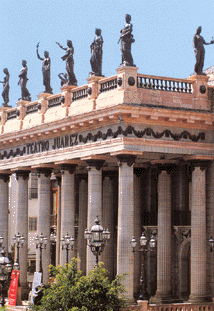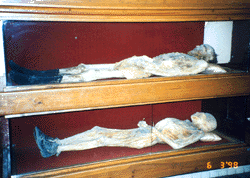Colonial Mexico
(Day 4 & 5) Guanajuato - Cont.
 Although
Guanajuato was sacked and many of the town's Spanish aristocracy
massacred, the revolutionaries did not remain in control for
long. In 1811, Hidalgo and three of his leaders were executed
near Chihuahua and their heads sent to Guanajuato to be hung
on hooks protruding from the four outside corners of the granary,
grisly reminders that this particular conflict was far from over.
The heads remained impaled until 1821, when Mexico finally won
its independence.
Although
Guanajuato was sacked and many of the town's Spanish aristocracy
massacred, the revolutionaries did not remain in control for
long. In 1811, Hidalgo and three of his leaders were executed
near Chihuahua and their heads sent to Guanajuato to be hung
on hooks protruding from the four outside corners of the granary,
grisly reminders that this particular conflict was far from over.
The heads remained impaled until 1821, when Mexico finally won
its independence.
Alhondiga de Granaditas (The granary) near the center of the
city, is one of Mexico's better museums. This massive 1809 structure
was originally a seed and grain warehouse. During the War of
Independence the Spanish Royalists of Guanajuato holed up in
the building until its door was set afire by a patriotic mine
worker nicknamed El Pípila (the young turkey). This victory
was later avenged when the heads of the four insurgents--Hidalgo,
Jiménez, Aldama and Allende--were gruesomely displayed
on the corners of the building; the hooks from which they hung
are still there. From the mid-19th to mid-20th centuries the
building functioned as a prison.
The museum contains varied
exhibits, including pre-Columbian stone artifacts, regional crafts
and costumes, and items from the extensive art collection of
muralist José Chávez Morado, most of which are
displayed at the Museo del Pueblo de Guanajuato. Morado murals
depicting revolutionary themes embellish the Alhóndiga's
stairwells. Bronze busts of the four revolutionary heroes preside
in a hall illuminated by an eternal flame.
Happily, those Spanish legacies that remain add immeasurably
to the city's picturesque air. It crowds the slopes of a dry,
narrow, rugged canyon. Houses hug the canyon's different levels,
with the foundation of one house sitting at the rooftop level
of the one below. The Spanish architectural influence is unmistakably
evident, but because Andalusians were among the early arrivals,
there is a Moorish touch to some early buildings, which are painted
in soft pastel colors and brightened with flower-filled window
boxes.
 Guanajuato's downtown core, like
the centers of Oaxaca, Morelia, Querétaro and other Mexican
colonial cities, maintains architectural integrity by restricting
gas stations and other concessions to contemporary living to
the suburbs and outlying areas. The city's twisting streets are
interspersed with little plazas, perfect for relaxing on a shaded
bench or perhaps chatting over coffee with one of the students
who attend the prestigious University of Guanajuato. Narrow callejónes
(lanes) shadowed by overhanging balconies follow the contours
of the hills; some are so steep in places that stairways are
built into the sidewalks.
Guanajuato's downtown core, like
the centers of Oaxaca, Morelia, Querétaro and other Mexican
colonial cities, maintains architectural integrity by restricting
gas stations and other concessions to contemporary living to
the suburbs and outlying areas. The city's twisting streets are
interspersed with little plazas, perfect for relaxing on a shaded
bench or perhaps chatting over coffee with one of the students
who attend the prestigious University of Guanajuato. Narrow callejónes
(lanes) shadowed by overhanging balconies follow the contours
of the hills; some are so steep in places that stairways are
built into the sidewalks.
Museo de las Momias (Mummy Museum), the city's ghastliest attraction,
is west of downtown on Calzada del Panteón, next to the
city cemetery (El Panteón). Dryness, minerals and natural
salts in the soil all helped preserve some 100 corpses, which
escaped decomposition to a remarkable degree. The first exhumations
were carried out in the 1860s when local citizens were unable
to pay for a gravesite.
 The mummies--men, women and children,
some still with shoes and hair--are displayed behind glass with
various frozen expressions, giving visitors the morbid thrill
of viewing them face to face. This museum is not recommended
for the squeamish or the claustrophobic (it's small and often
crowded). True to Mexicans' fascination with death, outdoor vendors
sell candy replicas of the mummies and young boys shout ''Las
momias!'' in an attempt to be hired as tour guides.
The mummies--men, women and children,
some still with shoes and hair--are displayed behind glass with
various frozen expressions, giving visitors the morbid thrill
of viewing them face to face. This museum is not recommended
for the squeamish or the claustrophobic (it's small and often
crowded). True to Mexicans' fascination with death, outdoor vendors
sell candy replicas of the mummies and young boys shout ''Las
momias!'' in an attempt to be hired as tour guides.
We spent two nights here. A good days sightseeing would be to visit the La Valenciana Mine and Church first. Then, head to the Mummy Museum (if interested!). Spend about two hours at the Granary Museum. Take a taxi to the scenic overlook where the statue of El Pípila is located. Walk down the hill to the Plaza and visit the Teatro Juarez (Juárez Theater), eat lunch or an early dinner at one of the many out door restaurants on the Plaza and then visit the fantastic covered Mercado (market) just down the street. this is a full days activity so allow plenty of time.
There is much more to do and see in Guanajuato. Three or four days would be needed to do it justice. But, unfortunately, we have to leave and head to our next destination, the beautiful Old Spanish town of San Miguel de Allende. En route we will stop for a few hours in Dolores Hidalgo, the home of the Mexican Independence movement.